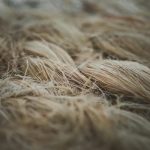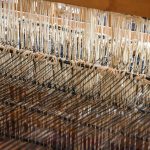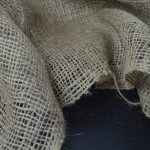Acetate fabric is a smooth, silky material made from cellulose treated with chemicals, giving it a soft feel and shiny silk-like appearance. You’ll find it lightweight, breathable, and excellent for elegant dresses or linings. It holds vibrant colors well but requires gentle care to maintain its look. While biodegradable, its production involves careful chemical use. If you want to discover how to style, care for, and choose acetate wisely, there’s plenty more to explore.
Table of Contents
Key Takeaways
- Acetate fabric is a silky, smooth textile made from cellulose acetate derived from wood pulp or cotton linters.
- It features a shiny finish, lightweight feel, breathable comfort, and drapes fluidly with a luxurious silk-like appearance.
- Commonly used in elegant evening wear and linings, acetate holds vibrant dyes and resists wrinkles.
- Care requires gentle hand washing in cold water without wringing to maintain its texture and appearance.
- Acetate is biodegradable but involves energy-intensive chemical processing requiring careful environmental management.
The History and Origin of Acetate Fabric
Acetate fabric traces its roots back to the early 20th century when chemists developed it as a silk alternative.
You’ll find that acetate quickly gained popularity because it mimicked silk’s luxurious look and feel but was more affordable.
During the 1920s and 1930s, it became a favorite for making elegant dresses and linings.
Acetate’s popularity soared in the 1920s and 1930s for crafting elegant dresses and linings.
You might be surprised to learn that its introduction transformed the textile industry by offering a synthetic option that still felt natural.
As you explore acetate fabric today, keep in mind it was originally designed to provide beauty and versatility without the high cost and care demands of real silk.
This history helps explain why acetate remains a popular choice for fashion and home décor items even now.
How Acetate Fabric Is Made
Understanding how acetate fabric is made gives you insight into its unique qualities.
First, manufacturers start with cellulose, typically derived from wood pulp or cotton linters. They chemically treat this cellulose with acetic acid and acetic anhydride, creating cellulose acetate. This process alters the cellulose at a molecular level, making it more flexible and glossy.
Next, the cellulose acetate dissolves in a solvent to form a thick liquid called dope. This dope is then extruded through spinnerets—tiny holes—that shape it into fine filaments. These filaments solidify as the solvent evaporates or is washed away, forming fibers.
Finally, the fibers are spun into yarn and woven or knitted into fabric. This careful process results in acetate fabric’s smooth texture and lustrous appearance.
Key Characteristics and Properties of Acetate
You’ll notice acetate fabric has a smooth, silky texture that feels soft against your skin.
It offers moderate durability but requires gentle care to maintain its appearance.
Understanding these traits will help you handle acetate properly and enjoy its unique qualities.
Fabric Texture and Feel
Though it often mimics the luxurious feel of silk, acetate has its own unique texture that sets it apart. When you touch acetate fabric, you’ll notice a smoothness that feels soft against your skin but with a cooler, almost crisp sensation.
Here are three key aspects of acetate’s texture and feel:
- Silky Smoothness – It glides gently, offering a soft, elegant touch without the weight of real silk.
- Light Sheen – The fabric has a subtle, glossy finish that catches light beautifully, enhancing its rich appearance.
- Breathable Comfort – Despite its smooth surface, acetate allows air flow, making it comfortable to wear in warmer weather.
You’ll appreciate acetate’s distinctive texture, especially when you want that silk-like look without the delicate nature of natural fibers.
Durability and Care
While acetate’s smooth texture and breathable comfort make it a pleasure to wear, knowing how to care for it properly guarantees it stays looking its best.
Acetate isn’t the most durable fabric—it can be prone to snagging and may weaken with prolonged exposure to heat. To maintain its quality, always hand wash or use a gentle machine cycle with cold water.
Avoid wringing it out; instead, gently squeeze excess water and lay flat to dry. Steer clear of high heat when ironing; use a low setting or a pressing cloth to prevent damage.
Common Uses of Acetate Fabric in Fashion
You’ll often find acetate fabric in elegant evening wear because of its smooth, lustrous finish that adds a touch of sophistication.
It’s also a popular choice for lining materials since it provides comfort and helps garments maintain their shape.
Understanding these uses can help you appreciate why acetate remains a favorite in fashion design.
Evening Wear Appeal
Because acetate fabric mimics the luxurious feel and sheen of silk, it has become a popular choice for evening wear designers.
When you choose acetate, you’re opting for elegance combined with affordability and practicality. This fabric enhances the overall look, giving your outfit a smooth, glossy finish that catches the light beautifully.
Here are three key reasons acetate shines in evening wear:
- Drape and Flow: Acetate drapes gracefully, creating flattering silhouettes perfect for gowns and dresses.
- Vibrant Colors: It holds dye well, so your evening wear will showcase rich, eye-catching hues.
- Comfort: Acetate feels soft against your skin, making it comfortable to wear through long events.
With acetate, you get stunning evening wear that looks high-end without the high price tag.
Lining Material Benefits
Since acetate fabric offers a smooth texture and excellent breathability, it’s a top choice for lining garments. When you choose acetate linings, you’re ensuring your clothes feel comfortable against your skin without trapping heat or moisture.
Its silky finish allows outer fabrics to drape beautifully while preventing friction that can damage delicate materials. You’ll also appreciate how acetate resists wrinkles, keeping your outfit looking polished throughout the day.
Plus, it’s lightweight, so it won’t add bulk or weight to your garments. Whether it’s a tailored jacket, a flowing dress, or a formal gown, acetate linings boost both comfort and durability.
Advantages of Choosing Acetate Over Other Fabrics
Although many fabrics offer unique qualities, acetate stands out for its blend of affordability, aesthetic appeal, and versatility. When you choose acetate, you’re opting for a fabric that balances style and practicality in ways that many others can’t match.
Here are three key advantages of choosing acetate over other fabrics:
- Luxurious Appearance: Acetate mimics the look and feel of silk, giving your garments a rich sheen without the high price tag.
- Breathability and Comfort: It feels smooth against your skin and allows air to flow, keeping you comfortable throughout the day.
- Color Retention: Acetate holds dye well, so your clothes stay vibrant longer, resisting fading even after multiple washes.
These benefits make acetate a smart choice for both everyday wear and special occasions.
How to Care for and Clean Acetate Fabric
When you want to keep your acetate garments looking their best, proper care and cleaning are essential.
Always check the care label first, as some acetate items require dry cleaning to maintain their shape and sheen.
If washing at home, hand wash in cold water with a mild detergent to prevent damage. Avoid wringing or twisting the fabric; instead, gently press out excess water.
Lay your garment flat to dry away from direct sunlight, which can fade colors.
When ironing, use a low heat setting and place a pressing cloth between the iron and fabric to avoid scorching.
Environmental Impact and Sustainability of Acetate
If you care about your fashion choices, understanding acetate’s environmental impact is essential. Acetate is a semi-synthetic fiber derived from wood pulp, which means it’s partially renewable but involves chemical processing. Here’s what you need to know:
- Resource Use: Acetate comes from cellulose, a natural material, but turning it into fabric requires energy-intensive chemical treatments.
- Biodegradability: Unlike many synthetic fabrics, acetate is biodegradable, breaking down more easily in the environment.
- Chemical Concerns: The production process uses solvents and chemicals that can be harmful if not managed responsibly.
Styling Tips: Wearing and Pairing Acetate Garments
Understanding acetate’s environmental profile can influence how you value and style garments made from this fabric. Since acetate often shines with a silky finish, pairing it with matte textures balances your look while highlighting its smoothness. It’s perfect for elegant occasions, but you can also dress it down with casual pieces for versatility.
Here’s how to style acetate effectively:
| Occasion | Styling Tip |
|---|---|
| Formal events | Pair with tailored blazers |
| Casual outings | Combine with denim pieces |
| Evening wear | Accessorize with metallics |
You’ll find acetate garments drape beautifully, so choose items that showcase their fluidity. Avoid bulky layers to keep your outfit sleek and sophisticated.
Frequently Asked Questions
Is Acetate Fabric Hypoallergenic?
You might find acetate fabric generally hypoallergenic since it’s smooth and unlikely to irritate sensitive skin. However, if you have extreme allergies, always test it first, as reactions can vary depending on individual sensitivities.
Can Acetate Fabric Be Used for Upholstery?
About 15% of upholstery uses acetate blends for their silk-like feel. You can use acetate fabric for upholstery, but it’s less durable than other fabrics, so you’ll want to avoid heavy wear areas to keep it looking good.
How Does Acetate Fabric React to High Heat?
You shouldn’t expose acetate fabric to high heat because it melts and shrinks easily. When you iron it, use a low temperature and always place a cloth between the iron and fabric to avoid damage.
Is Acetate Fabric Suitable for Athletic Wear?
You wouldn’t want to run a marathon in acetate fabric; it doesn’t wick moisture well and traps heat. So, if you’re aiming for comfort and breathability during workouts, acetate just isn’t your go-to athletic wear choice.
Does Acetate Fabric Fade in Sunlight?
Yes, acetate fabric can fade in sunlight because it’s sensitive to prolonged exposure. To keep your garments vibrant, avoid leaving them in direct sunlight for too long and store them in shaded areas whenever possible.
- How Abaca Fiber Is Used to Create Strong, Biodegradable Bags - June 25, 2025
- The Benefits of Abaca Fiber Reinforced Concrete in Modern Building - June 25, 2025
- Abaca Fiber Table Runners & Placemats: Elevate Your Dining Experience - June 25, 2025







